Which Scientist Used Data To Conclude That The Planets Moved In Elliptical Orbits Around The Sun?
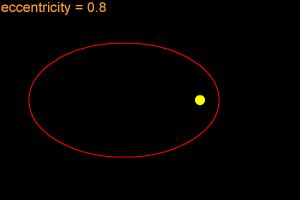
This blitheness shows elliptical orbits with different eccentricities; the locations of the two foci of one such ellipse; and the elements involved in the mathematical definition of an ellipse.
Click on image for total size
Original blitheness by Windows to the Universe staff (Randy Russell).
Elliptical Orbits
When one object is in orbit around another object, the orbit is normally an elliptical orbit. For case, all of the planets in our Solar Arrangement motion effectually the Lord's day in elliptical orbits. An ellipse is a shape that tin be thought of as a "stretched out" circle or an oval.
An ellipse can be very long and thin, or it can be quite round - almost similar a circle. In fact, a circumvolve is considered a special type of ellipse, in the same mode that a foursquare is considered a special type of rectangle. "Eccentricity" is the technical term that mathematicians and astronomers apply to describes how nearly circular (or not) an ellipse is. An ellipse with a small-scale eccentricity, like 0.1 or 0.2, is almost as round as a circumvolve. A long, sparse ellipse might accept an eccentricity of 0.8 or 0.9. A circle has an eccentricity of goose egg. The eccentricity of an ellipse must ever be less than 1, merely information technology can exist very, very close to one - similar 0.99, 0.999, or even larger!
When an object is in an elliptical orbit around another larger (more massive) object, the larger object is not at the heart of the ellipse. In that location are two points inside of an ellipse called the "foci" ("foci" is the plural form of "focus"). The larger objects is at ane of the 2 foci. For example, the Sunday is at one of the foci of Earth'south elliptical orbit. If the eccentricity of an ellipse is big, the foci are far apart. If the eccentricity is small, the foci are close together. In the extreme case of a circle, with an eccentricity of zero, the foci merge together into a unmarried point - the center of the circle.
Objects moving in elliptical orbits motion fastest when they are closest to the central torso, and most slowly when they are furthest from the central body. Johannes Kepler realized this and stated information technology in his Second Constabulary of Planetary Motion. The points of closest approach (and fastest movement) and furthest separation (and slowest motion) between the 2 objects take been given special names. For planets (or asteroids, comets, or spacecraft) orbiting the Sun, these points are called perihelion (close) and aphelion (far).
Strictly speaking, two objects really orbit each other, and it is the eye of mass of the 2-trunk system that they orbit around. In many actual cases, when one object is much larger (more than massive) than the other, nosotros are justified in making the approximation that the smaller object orbits the larger, and that the big object is at a focus of the orbital ellipse. For common cases like planets orbiting the Sun or the Moon orbiting Earth, this approximation is very close to the truth. All the same, there are some systems for which this approximation is not then expert. 2 such examples are the stars in a binary pair and duos of asteroids that orbit i another.
Let'south take a await at the mathematical definition of an ellipse. Showtime, place two points on a plane; these volition be the foci of the ellipse. Now, pick a distance that is larger than the distance between the 2 foci. We'll call that distance "2a", for reasons that volition become articulate in a infinitesimal. Let's say that a point "P" is on the ellipse. The distance from one focus (Fane) to P is r1; the distance from the other focus (Ftwo) to P is r2. A point P will exist on the ellipse if and only if the sum of its distances from the two foci adds up to 2a; that is:
r1 + rii = 2a
If we depict a line along the long centrality of the ellipse, through its center and both foci, the length of the ellipse along that axis will be 2a. The distance from the centre of the ellipse to either of its ends along that axis equals a. The value "a" is given a special name; it is called the "semi-major centrality" of the ellipse.
You can depict an ellipse using a string and two thumbtacks. Put a piece of newspaper on some cardboard, and stick the two thumbtacks into the paper. The locations of the thumbtacks will be the foci of the ellipse. Adhere 1 end of a piece of string, that is longer than the distance betwixt the tacks, to ane tack; adhere the other terminate of the string to the other tack. At present, stretch the string out to the side and draw forth it with the pencil, always keeping the string taut. You'll need to move the pencil at to the lowest degree once to draw both halves of the ellipse. By varying the length of the cord, you can draw different ellipses with dissimilar eccentricities. The string'due south length is 2a, the length of the major centrality of the ellipse.
You might as well be interested in:
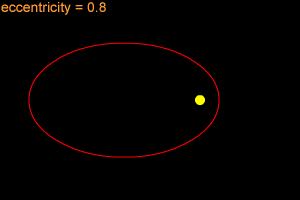
Eccentricity of an Orbit
Most objects in orbits movement along an elliptical path. An ellipse is a shape that can be thought of as a "stretched out" circle or an oval. An ellipse can be very long and sparse, or it can exist quite...more
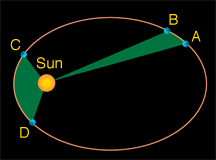
Kepler's Second Law: The Speeds of Planets
Kepler'southward second law he again discovered past trial and error. After some experimentation, Kepler realized that the line connecting the planet and the Sun sweeps out equal area in equal time. Look at the...more
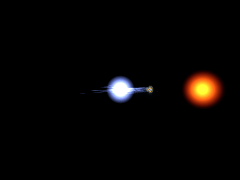
Algol
What's in a Proper noun: Arabic for "caput of the demon" Claim to Fame: Represents Medusa'southward eye in Perseus. A special variable star that "winks" every 3 days. Type of Star: Bluish-white Main Sequence Star, and...more

Moon Establish Orbiting Asteroid
A moon was discovered orbiting the asteroid, Eugenia. This is but the 2d time in history that a satellite has been seen circling an asteroid. A special mirror allowed scientists to observe the moon...more
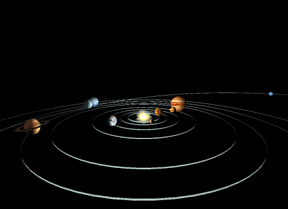
The Solar System
The solar system is made upwardly of the Sun, // Call the planets count function divers in the certificate head print_planet_count('planets'); planets and // Phone call the planets count role defined in the document...more than
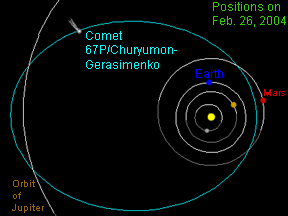
Mechanics
Mechanics is the term used to refer to ane of the primary branches of the scientific discipline of physics. Mechanics deals with the movement of and the forces that human activity upon physical objects. Nosotros demand precise terminology...more
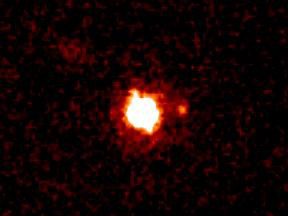
Eris - a dwarf planet
Eris is a dwarf planet that was discovered in 2005. Eris is a trans-Neptunian object (TNO) that orbits the Sunday on the frozen fringes of our Solar System beyond the Kuiper Belt. Eris takes 557 years to...more
Which Scientist Used Data To Conclude That The Planets Moved In Elliptical Orbits Around The Sun?,
Source: https://www.windows2universe.org/physical_science/physics/mechanics/orbit/ellipse.html&edu=high
Posted by: sylvestershent1937.blogspot.com


0 Response to "Which Scientist Used Data To Conclude That The Planets Moved In Elliptical Orbits Around The Sun?"
Post a Comment